Intro
Learn about Tonsil Removal Surgery, including benefits, risks, and recovery. Discover tonsillectomy procedures, adenoid removal, and throat infection treatments, improving overall ear, nose, and throat health.
The removal of tonsils, a common surgical procedure, has been a topic of interest for many individuals suffering from recurring tonsillitis or other tonsil-related issues. Tonsil removal surgery, also known as tonsillectomy, is a relatively straightforward operation that can provide significant relief from symptoms such as sore throats, difficulty swallowing, and breathing problems. In this article, we will delve into the world of tonsil removal surgery, exploring its importance, benefits, and what to expect during and after the procedure.
Tonsils are two small, oval-shaped masses of tissue located on either side of the back of the throat. They are part of the immune system and play a role in helping to fight off infections, particularly during childhood. However, for some people, tonsils can become a source of chronic infections, inflammation, and other issues, leading to a significant impact on daily life. Tonsil removal surgery is often recommended for individuals who experience recurring tonsillitis, sleep apnea, or other tonsil-related problems that do not respond to conservative treatments.
The decision to undergo tonsil removal surgery should not be taken lightly, as it is a surgical procedure that carries some risks and complications. Nevertheless, for many individuals, the benefits of tonsil removal surgery far outweigh the potential drawbacks. By removing the tonsils, patients can experience significant improvements in their overall health and well-being, including reduced frequency and severity of infections, improved sleep quality, and enhanced breathing and swallowing abilities.
Tonsil Removal Surgery: Benefits and Risks
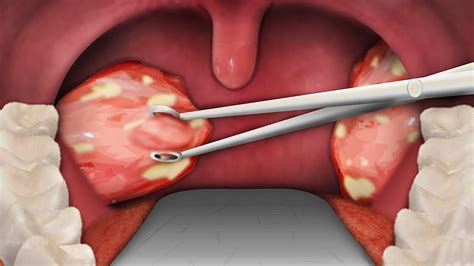
Tonsil removal surgery offers several benefits, including reduced risk of recurring tonsillitis, improved sleep quality, and enhanced breathing and swallowing abilities. The procedure can also help to alleviate symptoms such as sore throats, earaches, and headaches. However, as with any surgical procedure, there are also some risks and complications associated with tonsil removal surgery. These may include bleeding, infection, and reactions to anesthesia. It is essential to discuss the potential benefits and risks with a healthcare professional to determine if tonsil removal surgery is the right course of treatment.
Types of Tonsil Removal Surgery
There are several types of tonsil removal surgery, including traditional tonsillectomy, laser tonsillectomy, and radiofrequency tonsillectomy. Each type of procedure has its advantages and disadvantages, and the choice of which one to use will depend on the individual's specific needs and circumstances. Traditional tonsillectomy is the most common type of procedure and involves the removal of the tonsils using a scalpel or other surgical instrument. Laser tonsillectomy uses a laser to remove the tonsils, while radiofrequency tonsillectomy uses a specialized instrument that uses radiofrequency energy to remove the tonsils.Preparation for Tonsil Removal Surgery
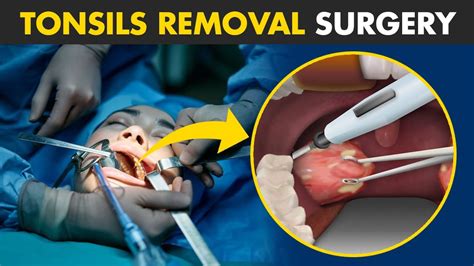
Preparation for tonsil removal surgery typically involves a series of tests and evaluations to ensure that the individual is a suitable candidate for the procedure. This may include a physical examination, blood tests, and imaging studies such as X-rays or CT scans. The healthcare professional will also provide instructions on how to prepare for the procedure, including any medications to avoid, dietary restrictions, and other pre-operative instructions.
What to Expect During Tonsil Removal Surgery
During tonsil removal surgery, the individual will typically be given general anesthesia to ensure that they are comfortable and pain-free during the procedure. The surgeon will then use a specialized instrument to remove the tonsils, taking care to minimize bleeding and trauma to the surrounding tissue. The procedure usually takes about 30-60 minutes to complete, and the individual will be taken to the recovery room to rest and recover after the procedure.Recovery from Tonsil Removal Surgery
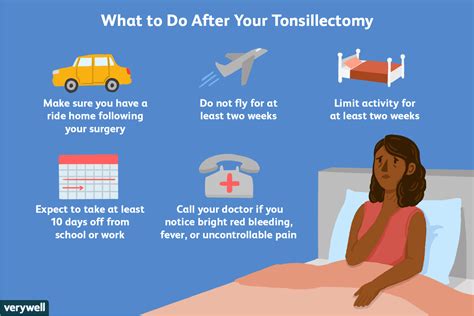
Recovery from tonsil removal surgery typically takes about 7-10 days, during which time the individual may experience some discomfort, pain, and bleeding. It is essential to follow the healthcare professional's instructions for post-operative care, including taking medications as directed, eating a soft diet, and avoiding strenuous activities. The individual may also experience some changes in their sense of taste and smell, as well as a white or yellowish coating on the tonsil area, which is a normal part of the healing process.
Complications of Tonsil Removal Surgery
While tonsil removal surgery is generally a safe and effective procedure, there are some potential complications that can occur. These may include bleeding, infection, and reactions to anesthesia. It is essential to seek medical attention immediately if the individual experiences any unusual symptoms, such as severe bleeding, difficulty breathing, or a high fever.Long-Term Effects of Tonsil Removal Surgery

The long-term effects of tonsil removal surgery are generally positive, with most individuals experiencing significant improvements in their overall health and well-being. However, some individuals may experience some changes in their sense of taste and smell, as well as a slightly increased risk of infections such as strep throat. It is essential to follow the healthcare professional's instructions for post-operative care and to attend follow-up appointments to ensure that the individual is healing properly.
Caring for Yourself After Tonsil Removal Surgery
Caring for yourself after tonsil removal surgery is crucial to ensure a smooth and successful recovery. This includes taking medications as directed, eating a soft diet, and avoiding strenuous activities. It is also essential to stay hydrated by drinking plenty of fluids, such as water and clear broths. The individual should also avoid smoking and secondhand smoke, as these can irritate the throat and slow down the healing process.Tonsil Removal Surgery in Children
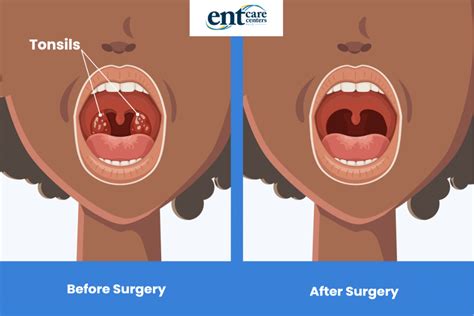
Tonsil removal surgery is often performed in children who experience recurring tonsillitis or other tonsil-related problems. The procedure is generally safe and effective in children, and can help to alleviate symptoms such as sore throats, earaches, and headaches. However, it is essential to discuss the potential benefits and risks with a healthcare professional to determine if tonsil removal surgery is the right course of treatment for the child.
What to Expect After Tonsil Removal Surgery in Children
After tonsil removal surgery, children may experience some discomfort, pain, and bleeding. It is essential to follow the healthcare professional's instructions for post-operative care, including taking medications as directed, eating a soft diet, and avoiding strenuous activities. The child may also experience some changes in their sense of taste and smell, as well as a white or yellowish coating on the tonsil area, which is a normal part of the healing process.Alternatives to Tonsil Removal Surgery
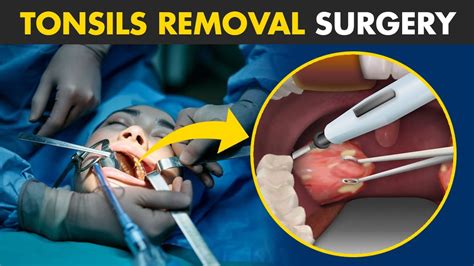
While tonsil removal surgery is often an effective treatment for tonsil-related problems, there are some alternatives that may be considered. These may include antibiotics, pain medications, and other conservative treatments. It is essential to discuss the potential benefits and risks of these alternatives with a healthcare professional to determine the best course of treatment.
Preventing Tonsil-Related Problems
Preventing tonsil-related problems is crucial to avoid the need for tonsil removal surgery. This includes practicing good hygiene, such as washing hands regularly and avoiding close contact with individuals who are sick. It is also essential to get plenty of rest, eat a healthy diet, and stay hydrated to help keep the immune system strong.What are the benefits of tonsil removal surgery?
+The benefits of tonsil removal surgery include reduced risk of recurring tonsillitis, improved sleep quality, and enhanced breathing and swallowing abilities.
What are the risks and complications of tonsil removal surgery?
+The risks and complications of tonsil removal surgery include bleeding, infection, and reactions to anesthesia.
How long does it take to recover from tonsil removal surgery?
+Recovery from tonsil removal surgery typically takes about 7-10 days, during which time the individual may experience some discomfort, pain, and bleeding.
In conclusion, tonsil removal surgery is a relatively straightforward procedure that can provide significant relief from tonsil-related problems. By understanding the benefits, risks, and alternatives to tonsil removal surgery, individuals can make informed decisions about their treatment options. If you or a loved one is considering tonsil removal surgery, it is essential to discuss the potential benefits and risks with a healthcare professional to determine the best course of treatment. We invite you to share your thoughts and experiences with tonsil removal surgery in the comments below, and to share this article with anyone who may be considering this procedure.
